Page 1626 - Clinical Small Animal Internal Medicine
P. 1626
1564 Section 14 Social and Ethical Issues in Veterinary Medicine
animal patients. In fact, many of the medical and surgical is in its best interest. It is up to the pet owner – the “pet
VetBooks.ir techniques now utilized in human medicine were first parent” – to listen to the explanation provided by the
veterinarian and veterinary healthcare team, to weigh
developed in animal models. There exists now a para-
digm in human and veterinary medicine that recognizes
and then to decide on behalf of the pet what treatment or
the importance of interdisciplinary collaboration in the options to try to determine the risk to benefit ratio,
order to foster synergistic attention to enhance the care procedure will be performed or withheld.
of animals, humans, and the environment. This is the This huge responsibility to act in the best interest of
One Health Initiative –www.onehealthinitiative.com/). the pet must be borne by both the owner and the veteri-
The mission statement of the One Health Initiative rec- narian coordinating care. In no other context of
ognizes “that human health (including mental health via veterinary care is this shared obligation greater than at
the human‐animal bond phenomenon), animal health, the end of life. The veterinarian possesses knowledge
and ecosystem health are inextricably linked” seeking to about the procedures and probabilities for various
“promote, improve, and defend the health and well‐being outcomes that the owner simply cannot know in the
of all species by enhancing cooperation and collabora- same way. The late physician Edmund Pellegrino, MD,
tion between physicians, veterinarians, [and]other scien- acknowledged to be the father of modern medical ethics,
tific and environmental professionals.” With such a would affirm by analogy that every time a veterinarian
commitment to cross‐pollination between medical disci- sees a patient and client and asks, “What is wrong?” she
plines, it is logical to consider ways in which palliative is committing herself to having the competence to help
and end of life care options for animals may be expanded. that animal patient as well as the judgment “to use that
In pursuing such expansion, however, it is critical also competence in the best interests of the patient.”
to expand the ethical framework within which palliative In the end of life time for animal patients, it is espe-
and end of life care decisions are made on behalf of pets cially important for veterinarians to find guidance in the
who are either experiencing life‐limiting disease or bioethical principles of respect for autonomy, nonma-
actively dying. In addition to applying human medical leficence, and beneficence as applied to their patients
principles and practices in end of life care for pets, in determining what actions – or withholding of
including aggressive pain management and other pallia- actions – are in the best interest of that animal at that
tive care techniques, it is appropriate for veterinary time, in dialogue with the pet’s human family. It is impor-
healthcare teams to understand and apply the founda- tant not to reach for euthanasia too early, but equally
tional clinical bioethical principles and practices as well. important not to withhold it when that action reflects
The pet owner is in an analogous situation to the parent the best interest of the animal. Reaching a decision about
of a dying child when making decisions on behalf of what will best serve the animal patient at the end of life
the pet. The pet clearly does not possess decisional may, in fact, demand answering the question mentioned
capacity – that is, the animal cannot weigh the evidence earlier in this chapter: “Just because we can, does that
and decide for itself, among the care options, which one mean we should?”
Further Reading
Beauchamp TL, Childress JF. Principles of Biomedical Ethics, Pellegrino ED. Professionalism, profession, and the
7th edn. Oxford, UK: Oxford University Press, 2013. virtues of the good physician. Mount Sinai J Med
Bekoff M, Pierce J. Wild Justice: The Moral Lives of 2002; 69(6): 379.
Animals. Chicago, IL: University of Chicago Press, 2009. Ryder RD. Painism: A Modern Morality. London: Open
McMillan FD. Do animals experience true happiness? In: Gate Press, 2001, p. 26.
McMillan FD, ed. Mental Health and Well‐being in Serpell J. In the Company of Animals: A Study of Human–
Animals. Ames, IA: Blackwell Publishing, 2005, Animal Relationships. Cambridge, UK: Cambridge
pp. 221–33. University Press, 1996.

